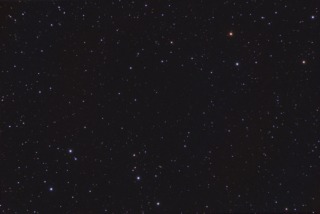
- Constellation: Aquarius
- Right Ascension: 23h 06m 29.368s
- Declination: −05° 02′ 29.04″
- Distance: 40.6 ly
- Apparent Magnitude: 18.8
Trappist 1 is a cool red dwarf star located in the constellation of Aquarius. It is a dim star at around 18.8 magnitude, barely visible in images taken with modest equipment. Discovered in 1999 by John Gizis and other colleagues, later it was determined by transit methods that 7 possible planets obit the star.
Images of it from 2020 and 2022 show a small amount of proper motion across the sky.
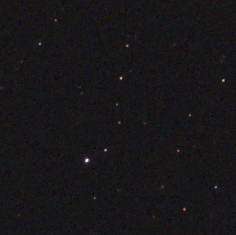
- Details
- Category: Stars
- Telescope: Explore Scientific 127 Refractor
- Camera: ZWO 2600 MM
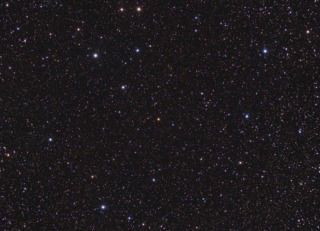
- Constellation: Ophiuchus
- Right Ascension: 17h 57m 48.49803s
- Declination: +04° 41′ 36.2072″
- Distance: 5.9 ly
- Apparent Magnitude: 9.5
Barnard's Star, being one of the closest stars to our solar system, displays one of the highest proper motion, which is the apparent angular movement of a star against the background stars. Just like highway signs appear to move faster than distant landmarks. It is a dim red dwarf star that requires optical aid to see it. It has a B-V color index of 1.7
A composite picture of images taken in July of 2014, and in July of 2022 showing the different positions against the background stars.
- Details
- Category: Stars
- Telescope: Explore Scientific 127 Refractor
- Camera: ZWO 2600 MM
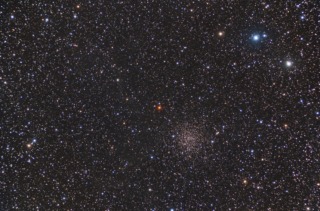
- Constellation: Lyra
- Right Ascension: 19 20 09.1511530426
- Declination: Dec +37 52 36.915069066
- Distance: 10457 ly
- Apparent Magnitude: 8.3 - 13.5
Continuing the journey through Lyra's carbon stars we have U Lyr. It varies in magnitude from 8.3 down to 13.5 in around 451 days. It is also an optical double star with the other star just visible in the 2:00 position in the halo of the image. An optical double is just a chance alignment ot two stars. Like most carbon stars it tend to be very reddish, but the red tends to be over-saturated in images giving it a more orangeish appearance. Its actual B-V color index is 4.63.
Just to the lower right of it is an interesting open cluster NGC 6791.
- Details
- Category: Stars
- Telescope: Explore Scientific 127 Refractor
- Camera: ZWO 2600 MM
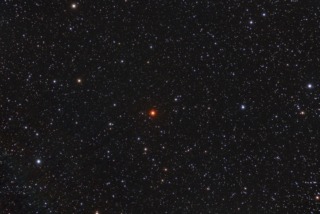
- Constellation: Lyra
- Right Ascension: 18h 32m 20.10s
- Declination: +39° 59′ 55.6″
- Distance: 2350 ly
- Apparent Magnitude: 7.5 - 9.2
Continuing through Lyra's carbon stars, we have T Lyr, a slow irregular period variable star that varies between 7.5 and 9.2 magnitude.
- Details
- Category: Stars
- Telescope: Explore Scientific 127 Refractor
- Camera: ZWO 2600 MM
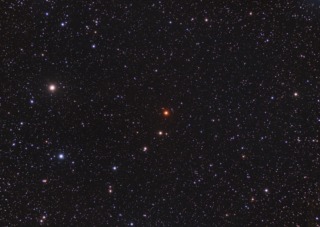
- Constellation: Lyra
- Right Ascension: 18h 42m 50.00s
- Declination: +36° 57′ 30.9″
- Distance: 4468 ly
- Apparent Magnitude: 7.5 - 8.4
HK Lyr is a semi-regular variable carbon star, and easy to identify in this image due to its reddish-orange color. On a approximate period of 186 days, its magnitude varies between 7.5 and 8.4. It's B-V index is 3.08.
- Details
- Category: Stars
- Telescope: Explore Scientific 127 Refractor
- Camera: ZWO 2600 MM
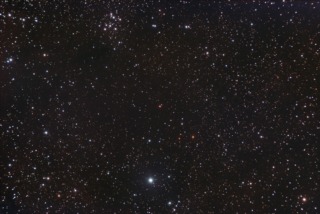
- Constellation: Cygnus
- Right Ascension: 20h 25m 58.04s
- Declination: +38° 21′ 07.7″
- Distance: 5,000 ly
- Apparent Magnitude: 10.60 - 11.74
A red super giant star located the constellation of Cygnus. Interstellar dust and gas in that area dims reddens the star. Some of that dust can be seen as darker splotches dimming the stars behind it. A variable star, but no regular repeatable cycle.
- Details
- Category: Stars
- Telescope: Explore Scientific 127 Refractor
- Camera: ZWO 2600 MM